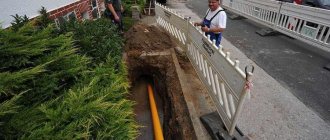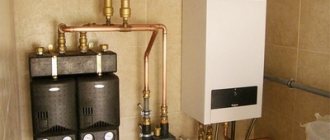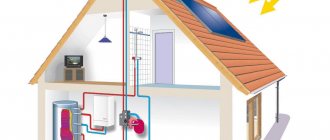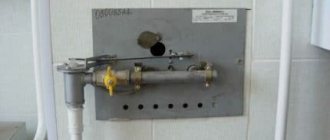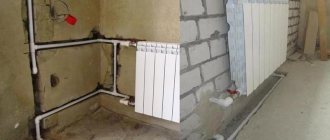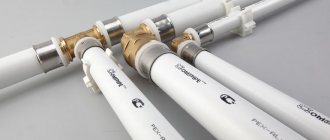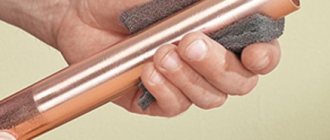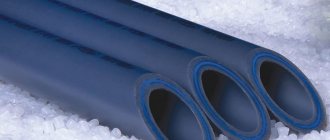Gas is supplied to the end consumer in apartments and houses through a distribution network. Transportation is carried out through pipes for which certain GOST standards are established. The same standards establish the service life of gas pipes in residential buildings for their various types.
After the expiration of the operating period specified by the manufacturer, the gas pipeline must be completely replaced. This should be monitored by specialized control services, however, it would also be useful for consumers to know how long the pipes should be used, how to determine the degree of their wear and the need for replacement.
What does service life mean?
Service life is the calendar duration of the period of use of mains and gas pipeline branches connected to them from the beginning of commissioning of the system or after its repair until transition to the limit state. It is determined by the manufacturer of gas pipes, as indicated in the certificate.
There is no universal service life limit as such. In each specific case, it is determined individually, since one gas pipeline is operated in favorable conditions, while the other is deformed and destroyed much faster due to the influence of external factors.
Service life of cast iron sewer pipes in an apartment
Regular cleaning of pipes from internal and external deposits will help increase their service life.
The latter is more difficult to deal with, since it requires access to the surface of the pipes, but internal deposits are easier to deal with. It is enough to flush the pipeline from time to time. Based on this, it becomes clear that preventive maintenance and timely ongoing repairs of the sewer system should be one of the priorities facing not only the utility organizations serving the house, but also the residents themselves. To do this, they need to know how the sewage system works in an apartment building: the diagram of which allows them to understand the principles of its operation (about
Regulatory framework: what does the Law say?
According to Order No. 558 dated November 21, 2013, which regulates safety rules when handling liquefied gas.
Technical inspection of an underground gas pipeline is carried out after the expiration of the estimated service life, which is for:
- steel pipes – 40 years;
- polyethylene pipes – 50 years.
Pipelines assembled from polymer pipes last longer due to higher resistance to mechanical and chemical influences, as well as the absence of prerequisites for the appearance and spread of mold.
In this case, during such diagnostics the following parameters should be checked:
- gas pipeline tightness;
- protective coating (for steel pipes);
- the condition of the material from which the gas pipeline is made;
- quality of welding at joints.
Early inspections are carried out only in case of accidents or receipt of reliable information about the deformation of gas pipelines underground.
Surveys are still carried out in accordance with the instructions from RD 204 of the RSFSR 3.3-87, approved back in 1987. The provisions contained in the Decree of the Government of the Russian Federation of October 29, 2010 N 870, contain rather vague wording regarding this issue.
Thus, paragraph 76 states that the operational life is determined at the time of design, taking into account the conditions for ensuring the safety of objects, the forecast regarding changes in their parameters, as well as the guarantees for pipe products provided by the manufacturer.
In addition, this act states that the gas pipeline can be operated even after the expiration of its service life, if diagnostics did not reveal any serious malfunctions in the operation of the system or defects in the pipes. Based on the results of such diagnostics, the service life limits should be re-established.
As for external gas pipelines and equipment, as a rule, their service life is shorter. In any case, you should always pay attention to their working “experience”, which is indicated by the manufacturer.
For example, the manufacturer “Gazovik” for GRPSh-6, 10 and 10MS defines the following terms:
- average (before write-off) – 15 years;
- warranty period – 5 years.
But “First Gas Company” in the passports for most of its gas distribution plants indicates a 20-year period, which, by the way, is the average for gas turbine installations.
Service life of gas pipes in an apartment building: standards and operating features
- The thickness of the wall of the wired product should be about 3 mm for laying underground, the thickness of the wall for laying above ground should be at least 2 mm;
- the diameter of steel products for gas pipelines can be from 15 to 100 mm;
- the throughput of such products ranges from 3 to 12 atmospheres, the indicator depends on the location of passage.
Gas supply to a populated area is carried out through a distribution network. The delivery scheme involves the passage of fuel through gas pipes to equipment installed in a residential area in accordance with accepted standards and the requirements of special control services.
What factors influence the condition of gas pipelines?
As the experience of leading Russian expert organizations shows, underground steel gas pipelines retain their physical and mechanical properties even after forty years of service. Welded joints are also kept within regulated limits so their service life is extended.
But this does not happen for all pipes and still not always, so you need to figure out what determines the condition of pipes with identical characteristics over time.
The actual state of the pipeline and the time it takes for it to reach the limiting state depends on:
- the correctness of engineering decisions made at the time of design;
- integrity of construction and installation work;
- quality of materials used in construction;
- level of soil corrosion activity;
- effectiveness of electrochemical protection;
- monitoring;
- regularity and quality of repairs, etc.
Service life of gas pipes in an apartment building pressure, throughput, standards for
Gas supply to a residential area is carried out through a distribution network. The delivery scheme involves the passage of fuel through gas pipes to equipment installed in residential premises in accordance with accepted standards and the requirements of specialized control services.
- the thickness of the wall of the wired product should be about 3 mm for laying underground, the thickness of the wall for laying above the ground should be at least 2 mm;
- the diameter of steel products for gas pipelines can be from 15 to 100 mm;
- the throughput of such products varies from 3 to 12 atmospheres, the indicator depends on the location of passage.
What are the signs that determine the need for replacement?
The conditional standard service life was indicated above. They are “detached” from reality and are exemplary. In some cases, a gas pipeline may fail earlier, or it may last much longer than the average service life of gas pipes in industrial and residential buildings and industrial facilities.
In practice, the service life of a gas pipeline made of steel pipes is on average 30 years.
It is also worth noting that it is not possible to determine the condition of steel structures “by eye” by external signs. Utility service employees must carry out appropriate examinations and measurements.
Signs by which it can be determined that a gas pipeline needs pipe replacement are:
- thinning of the walls is higher than normal;
- change in the nature of connections at welding sites;
- gas leak according to meter readings.
Their results are reflected in protocols, which the consumer has the right to review. In addition, he may require an oral explanation of the material presented.
What to do if the service life of the gas pipeline has expired?
If their service life expires, they must be repaired, which includes complete or partial replacement of elements.
If an inspection has already been carried out by competent persons and they have concluded that a replacement is necessary, the consumer no longer needs to do anything. Repair work must be carried out by employees of GorGaz or other similar services servicing the facility.
To completely replace the gas pipeline, a mobile team is sent to the site, which removes the failed sections of the main passage to the common pipe complex, and then looks at the situation.
Partial replacement of pipes in a multi-story building is carried out by cutting off old sections and placing new ones using welding.
Such events are carried out strictly in accordance with safety rules:
- Gas access to the pipes is blocked.
- From the site that will be replaced, gas must be completely removed in accordance with safe handling standards for hazardous facilities.
- The old section is cut off.
- Using welding, a new element is mounted in its place.
- The integrity and tightness of the area is being checked.
- Starting a gas flow through the pipe after they have been purged.
You cannot repair gas equipment yourself. This is a complex and dangerous process that can only be carried out by gas industry employees with the necessary equipment.
Moreover, the fact that such work was carried out, as well as the date of its implementation, must be entered into the technical passport, which notes all actions carried out with the system. This is necessary so that the service life of the new gas pipeline can subsequently be determined.
If the consumer has suspicions that the pipes have become unusable, he can make a request to the relevant utility services and wait for their employees to arrive, but in no case should they check their version without their presence.
Safety regulations
Gas is a cheap type of fuel, burns without residue, has a high combustion temperature and, as a result, a high calorific value, however, when mixed with air, it is explosive. Unfortunately, gas leaks are not a rare occurrence. In order to protect yourself as much as possible, you must strictly follow the safety rules.
First of all, it is necessary to study the operating instructions for gas equipment and follow them, monitor the normal operation of gas appliances, chimneys and ventilation.
Household liquefied gas consists of a mixture of propane and butane, has no color or odor of its own, so a strong-smelling odorant substance (ethyl mercoptane) is added to it, which gives it the smell of a rotten egg, to quickly detect a leak by smell.
Owners of residential premises are prohibited from disturbing the ventilation system of residential premises during redevelopment and reconstruction of the apartment. Before igniting the gas stove, the room must be ventilated, leaving the window open for the entire time you work with the stove. The tap on the pipe in front of the stove is opened by moving the handle flag to a position along the pipe.
The flame should light up in all burner holes and have a bluish-violet color without smoking tongues. If the flame is smoky, the gas does not burn completely, you need to contact the specialists of the gas supply company and adjust the air supply. Please note: if the flame comes off the burner, this means that too much air is coming in, and under no circumstances should you use such a burner!
Household liquefied gas is 2 times heavier than air, so when there is a leak, it primarily fills the lower rooms and can spread over distances, so even a small leak can cause suffocation and cause a fire.
If you notice the characteristic smell of gas in the room, you should not turn on or turn off any electrical appliances to avoid causing an electric spark, which could lead to a gas explosion. In this case, it is urgent to shut off the gas pipeline and ventilate the room. If you go to the country or on vacation, you must turn off the gas by turning the tap on the pipe. Ideally, you should turn off the gas valve after each use of the stove or oven.
You must immediately contact the emergency gas service in the following cases:
- you can smell gas in the entrance;
- if you discover a malfunction of the gas pipeline, gas taps, gas appliances;
- when the gas supply suddenly stops.
Remember that inspection and repair of gas equipment can only be carried out by gas industry workers. Their authority is confirmed by official identification, which they must present to the owner of the apartment.
Photo: ShutterStock/Fotodom.ru
What to do to extend the service life?
In fact, how long a gas pipeline will last depends, among other things, on the consumer.
To extend its service life, you must systematically follow simple rules:
- Rule #1. Timely inspection and inspection of pipes. To do this, you need to let the inspectors in and try to stay at home if the time of the inspection is announced in advance.
- Rule #2. Turning on equipment in the correct sequence. Carrying out pressure testing of the gas system in accordance with the instructions and safety rules. The consumer must know which valve is responsible for what. If you are not aware of this, it is better to consult the gas workers servicing your home.
- Rule #3. Urgent check if there is a suspected gas leak. You should call your gas service immediately. They are obliged to promptly leave for the specified address. Before their arrival, it is better to turn off the gas valve in the apartment.
You can check the leak yourself as follows: in areas of the pipes where the smell of gas is especially noticeable, coat the suspicious area with soap foam. If bubbles begin to swell in the area, there is most likely a leak.
However, this is not a 100% leak detection method, much less a professional one. But for domestic use in the absence of professional equipment, it is quite suitable and, as practice shows, quite effective.
Conclusions and useful video on the topic
For calculations, the strength determined at a temperature of 20 ° C for a service life of 50 years according to ISO 9080 is taken:
Compliance with the deadlines specified by building regulations and guaranteed by the manufacturer is necessary to ensure the safe operation and operation of the system. Checking the technical condition of the gas supply, which is classified as explosive communications, is a necessary measure. It will eliminate risks and a lot of problems.
Please write comments in the block below, post photos and ask questions about the topic of the article. Tell us about your experience in inspecting gas pipes and identifying their critical technical condition. Share useful information that may be useful to site visitors.
When developing gas supply projects, it is necessary to include data on the service life of gas distribution system facilities in the explanatory note: Service life of gas distribution system, polyethylene and steel above-ground and underground gas pipelines.
Standards for gas pipes in a private house
When carrying out gasification of a country house, you should rely on the following regulatory requirements:
- If a gas boiler with a power of ≤ 60 kW is installed, then the ceiling height in the room must be ≥ 2.4 m;
- Windows in the boiler room must occupy at least 0.8 m2, or 0.03 m2 per 1 m3;
- When one boiler is supposed to operate (without emergency backup), the area of the boiler room should be ≥ 7.5 m2, when installing two boilers - 15 m2;
- If a boiler with a power of ≥ 60 kW is installed in the basement of a house, then a gas detector must be installed in the room;
- When using two-burner gas stoves in the kitchen, the volume of the kitchen space must be ≥ 8 m3, when using four-burner stoves - 15 m3;
The places where the gas main enters the house are calculated when drawing up the project; a metal cabinet for storing gas cylinders is attached to the foundation and to the wall of the house. When laying a gas pipe from the cabinet to the building, the following rules must be observed:
- The metal gas pipeline is laid at a height of ≥ 2.5 m;
- Pipes are attached to the walls of the house with clamps and anchors;
- Pipes should not pass through windows or doorways.
We recommend reading: Minibus travel is free
Service life of GRPS
The service life of gas-propelled gas pumps is established by the manufacturer of gas-using equipment.
For example, Gazovik sets the following deadlines for GRPSh-6, 10 and 10MS:
Average service life before write-off – 15 years
The warranty period is 5 years.
“First Gas Safety Rules in the Gas Industry”: ( Canceled . ->
Replaced by PB 12-368-00 Safety rules in the gas industry. Canceled . ->
Replaced by PB 12-609-03 Safety rules for facilities using liquefied petroleum gases. Canceled . ->
Replaced by “ Federal norms and rules in the field of industrial safety “Safety rules for facilities using liquefied hydrocarbon gases ”)
3.3.28. Extraordinary technical inspections (diagnostics of the technical condition) of gas pipelines should be carried out after the expiration of the design service life, accepted for steel gas pipelines of 40 years and for polyethylene 50 years. Diagnostics in order to determine the need for replacement or residual life with the development of measures to ensure the safe operation of the gas pipeline for the entire period of life cycle extension, should include checking: the tightness of the gas pipelines; condition of the protective coating (for steel gas pipelines); condition (wear) of the material of the pipes from which it is built; quality of welded joints. The inspection must be carried out in accordance with RD 204 of the RSFSR 3.3-87 “Technical condition of underground gas pipelines. General requirements. Assessment methods”, approved by the Ministry of Housing and Utilities of the RSFSR in 1987.
In the document “ Federal norms and rules in the field of industrial safety “Safety rules for facilities using liquefied petroleum gases ”
The only relevant item:
56. Diagnostics should be carried out after the expiration of the service life established by the manufacturers, but not more than: 20 years for technical devices; 30 years for gas pipelines.
The Document “ Resolution of the Government of the Russian Federation of October 29, 2010 N 870 ” states:
76. The duration of operation of gas pipelines, technical and technological devices is established during design based on the condition of ensuring the safety of technically regulated objects in the event of predicted changes in their characteristics and the guarantees of the manufacturer of technical and technological devices. To establish the possibility of operating gas pipelines, buildings and structures and technological devices of gas distribution and gas consumption networks after the deadlines specified in the design documentation, their technical diagnostics must be carried out. The deadlines for further operation of objects of technical regulation of this technical regulation should be established based on the results of technical diagnostics.
The document “ RD 12-608-03 – Regulations for conducting industrial safety examinations at gas supply facilities”, clause 4.2 (Cancelled) tells us:
. An examination of gas equipment in operation is carried out at the end of its service life established by the manufacturer ; in the absence of this information, diagnosis is made after 20 years .
Document “ PB 12-529-03 – Safety Rules for Gas Distribution and Gas Consumption Systems” clause 5.5.2 (Canceled. Replaced with “ Federal Norms and Rules in the Field of Industrial Safety “Safety Rules for Facilities Using Liquefied Petroleum Gases ”).
5.5.2. Diagnosis should be carried out after 40 years for steel above-ground in embankments, underground, as well as 50 years for polyethylene gas pipelines after their commissioning. Early diagnosis of gas pipelines is prescribed in cases of accidents caused by corrosion damage to steel gas pipelines, loss of strength (rupture) of welded joints, as well as in the case of construction of steel gas pipelines beyond the standard period in highly corrosive soils without electrochemical protection. The decision to carry out diagnostic work or reconstruction (replacement) of the gas pipeline is made by the owner of the gas distribution network.
Document “ PB 12-609-03 – Safety Rules for Facilities Using Liquefied Petroleum Gases” clause 5.3.7 (Canceled. Replaced with “ Federal Norms and Rules in the Field of Industrial Safety “Safety Rules for Facilities Using Liquefied Petroleum Gases ”):
5.3.7. Existing external gas pipelines must be subject to periodic inspections, instrumental technical inspection, technical condition diagnostics, as well as routine and major repairs. Underground gas pipelines with a service life are subject to diagnosis: steel - 40 years; polyethylene - 50 years. Gas equipment (technical devices) are subject to diagnostics after the service life established by the manufacturer, but not more than 20 years of operation.
If you are already registered, enter your login information!
Previous article Next article
Gas pipelines and gas equipment of residential buildings
Approved and put into effect by Decree of the Moscow Government No. 758-PP
1. General Provisions
1.1. The requirements of this standard are aimed at ensuring the safe and efficient functioning of internal gas pipelines and gas equipment of residential buildings.
1.2. This standard applies to the design and construction of new, operation and repair of existing in-house gas supply systems for residential buildings built according to standard and individual designs.
1.3. The requirements of this standard are mandatory for fulfillment by: owners and other legal owners of residential buildings; management and (or) organizations servicing residential buildings; organizations - customers/contractors for construction, reconstruction, maintenance and repair.
1.4.
This standard was developed by the State Housing Inspectorate of the city of Moscow. 2. Basic concepts.
For the purposes of this standard, the following basic concepts are used:
2.1. An internal gas pipeline (also known as an intra-house gas pipeline) is a gas pipeline laid inside a building from the place of its primary intersection of the building structures to the point of connection of gas appliances and devices that use gas as fuel for cooking, hot water supply, and decentralized heating.
2.2. In-house gas equipment - technical products of full factory readiness: gas meters; pipeline shut-off valves; gas appliances and apparatus.
2.3. Gas appliances and appliances are household gas appliances that use gas as fuel for cooking, hot water supply and decentralized heating.
2.4. An in-house gas supply system is a single system consisting of an internal gas pipeline and in-house gas equipment installed on it.
2.5. A chimney is a structural element of a building designed to remove gas combustion products to the external environment from household gas appliances used for hot water supply and heating.
2.6. Cleaner organizations are enterprises that carry out maintenance and major repairs of chimneys.
3. Requirements for intra-house gas supply systems of residential buildings.
3.1. The design, construction, reconstruction and repair of gas supply systems are carried out by specialized organizations in accordance with the requirements of building codes and standards.
3.2. The need for repairs of internal gas pipelines, gas equipment of residential buildings and chimneys is determined in the prescribed manner based on the results of an inspection of their technical condition and taking into account the standard service life.
3.3. Gas pipeline entries into residential buildings must be provided in non-residential premises accessible for inspection and repair of gas pipelines. It is not allowed to enter gas pipelines into basements, elevator rooms, ventilation chambers and shafts, waste disposal rooms, warehouses, rooms classified as explosion and fire hazard categories “A” and “B”, as well as into rooms removed from the housing stock. All basement gas pipelines located in residential buildings in the city must be located on the facades of buildings.
3.4. Gas pipelines where they pass through the external walls of residential buildings are enclosed in cases. The space between the gas pipeline and the casing is sealed to the full thickness of the wall being crossed. The end of the case is sealed with elastic material.
3.5. Shut-off devices are installed for gas risers, as a rule, on wall-mounted gas pipelines of residential buildings, at a distance of at least 0.5 meters from door and window openings, as well as in front of each gas appliance.
3.6. Intra-house gas pipelines are laid through non-residential premises of apartments.
3.7. Laying gas pipelines is not allowed: in basements; through ventilation shafts and chimneys, elevator shafts and staircases, waste disposal rooms; through rooms where the gas pipeline may be subject to corrosion; in places where gas pipelines may be washed by combustion products or come into contact with heated metal; in premises removed from the housing stock; by crossing ventilation grilles, window and door openings.
3.8. Installation of gas pipelines is carried out in accordance with the project after arrangement of interfloor ceilings, walls, floor coverings and plastering of walls in kitchens, inspection and cleaning of chimneys and ventilation ducts.
3.9. Gas pipelines inside a residential building are laid openly. It is not allowed to cover the gas pipeline with a false wall. When installing gas pipelines, measures are taken to prevent clogging of the pipe cavity. At the intersections of the electrical wire and cable with the gas pipeline, the clear distance between them must be at least 100 mm, and for parallel installation - at least 400 mm.
3.10. The distance from gas pipelines and pipelines for other purposes should be taken from the condition of ensuring the possibility of installation, inspection, and repair of gas pipelines and the fittings installed on them. The distance from the gas pipeline to the sink must be at least 300 mm.
3.11. Deviation of risers and straight sections from the design position is allowed no more than 2 mm per 1 m of gas pipeline length, unless other standards are justified by the design. All branches must be made at an angle of 90 degrees.
3.12. It is prohibited to weld branch pipes at the locations of circumferential welds. When inserting branches with a diameter of up to 50 mm, the distance from the seams of the welded gas pipelines to the circumferential seams of the main gas pipeline must be at least 50 mm. Assembly for welding of pipes is carried out with offset seams at the joining points: - for gas pipelines with a diameter of up to 50 mm - 15 mm; - for gas pipelines with a diameter from 50 to 100 mm - 50 mm.
3.13. The distance from the weld to the end of the gas pipeline thread must be at least 100 mm. Sealing welded and threaded connections of gas pipelines and fittings into walls, ceilings and cases is prohibited. Hidden work (laying a gas pipeline through walls, in a case, through a ceiling) is carried out step by step. The distance from the weld to the case must be at least 50 mm. The welded joint of a gas pipeline with a diameter of up to 200 mm must be located at a distance of at least 200 mm from the edge of the support.
3.14. When welding shaped parts, assemblies, and fittings into a gas pipeline, the integrity of the welded elements with the gas pipeline is ensured. Distortions in vertical and horizontal planes are prohibited. It is prohibited to install pipes and bent parts made from pipes that have dents, folds (wrinkles), cracks, slag inclusions in the seams, or burrs. Ovality of bent parts is allowed within no more than 10% of the gas pipeline diameter. It is prohibited to construct a straight section of the outlet, the length of which is less than the diameter of the pipe.
3.15. The laying of gas pipelines in places where people pass is carried out at a height of at least 2.2 m from the floor to the bottom of the gas pipeline.
3.16. The gas pipeline is fastened to the walls using brackets, clamps, and hooks in accordance with the requirements of the project. Fastening the gas pipeline riser in houses with gas stoves is carried out on the 1st, 4th, 8th floors, in houses with gas water heaters on the 1st, 4th, 5th floors and in all cases on the top floor. Attaching the gas pipeline lower to the device is carried out in front of each gas device. The distances between the support fastenings of gas pipelines are determined in accordance with the requirements of SNiP 2.04.12-86.
3.17. Vertical gas pipelines at intersections of building structures are laid in cases. The space between the gas pipeline and the case is sealed with tarred tow, rubber bushings or other elastic material. The protrusion of the end of the casing above the floor must be at least 3 cm, and its diameter is taken from the condition that the annular gap between the gas pipeline and the casing is at least 5 mm for gas pipelines with a diameter of no more than 32 mm and at least 10 mm for gas pipelines of larger diameter.
3.18. Internal gas pipelines, including sections laid in casings, are painted. Waterproof paints and varnishes are used for painting.
3.19. When installing a gas pipeline inside a residential building, pipes are used that are specially designed for laying a gas pipeline, have a metal design and a certificate of conformity. Pipe connections should be made by welding. Threaded connections are allowed only in places where shut-off valves and gas appliances are installed.
3.20. To seal threaded connections, flax strands are used in accordance with GOST 10330-76, impregnated with red lead in accordance with GOST 19151-73, mixed with drying oil in accordance with GOST 7931-76, as well as fluoroplastic and other sealing materials if they have a passport or certificate from the manufacturer. When installing disconnecting devices, a surge is installed after them. The taps must be installed so that the axis of the tap plug is parallel to the wall; it is prohibited to install the thrust nut towards the wall. When installing gas appliances and connecting them to gas networks, you must comply with the requirements of the project and factory instructions.
3.21. The gas pipeline to the stove can be laid at the level of the connecting fitting. In this case, the shut-off valve is installed at a distance of at least 20 cm to the side of the stove. For overhead wiring, the shut-off valve should be installed on the descent to the slab at a height of 1.5 - 1.6 m from the floor. It is allowed to connect gas appliances to the gas pipeline through a flexible hose that does not have butt joints and has a heat resistance of at least 120 degrees. The service life is established by the passport for the flexible hose, after which the flexible hose must be replaced.
3.22. Sections of gas pipelines that are disconnected during dismantling of gas appliances are cut off, freed from gas and welded tightly. When the gas pipeline is removed from the basement, the inactive basement gas pipeline and sections of the gas pipeline through the ceilings to the switching point are dismantled, and the holes in the floor are sealed. When installing gas pipelines, it is prohibited to use previously installed gas pipes and casings that are subject to dismantling as a casing.
3.23. At all stages of construction, in order to verify the effectiveness of previously performed production controls, inspection controls should be carried out selectively. Based on the results of production and inspection quality control of construction and installation works, measures must be developed to eliminate identified defects, while the requirements of designer supervision of design organizations and state supervision and control bodies operating on the basis of special provisions must also be taken into account.
3.24. Gas stoves in residential buildings are installed in kitchens with a height of at least 2.2 m, which have a window with a window (transom), an exhaust ventilation duct and natural lighting. Gas stoves are installed in kitchens with an internal volume of at least 8 cubic meters. m with a gas stove with 2 burners; 12 cu. m with a gas stove with 3 burners; 15 cu. m with a gas stove with 4 burners.
3.25. In existing residential buildings, the installation of gas stoves is allowed: in kitchens with a height of at least 2.2 m and a volume of at least specified in clause 3.24 in the absence of a ventilation duct and it is impossible to use chimneys as such a duct, but if there is a window with a window or transom at the top of the window; in private corridors, if there is a window in the corridor with a window or transom in the upper part of the window, the passage between the slab and the opposite wall must be at least 1 m wide, the walls and ceilings of the corridors made of flammable materials must be plastered, and the living quarters must be separated from the corridor by dense partitions with a door; in kitchens with sloping ceilings with a height in the middle part of at least 2 m, gas equipment is installed in that part of the kitchen where the height is at least 2.2 m.
3.26. In existing residential buildings, it is allowed to install gas stoves in premises that meet the requirements of paragraphs. 3.24 or 3.25, but having a height of less than 2.2 m up to 2 m inclusive, if these premises have a volume of at least 1.25 times the standard. Moreover, in houses that do not have a dedicated kitchen, the volume of the room where the gas stove is installed must be 2 times larger than that specified in clause 3.24.
3.27. The possibility of installing gas stoves, heating and other devices in buildings located outside a residential building is decided by the design organization and the operational organization of the gas industry. At the same time, the premises in which the installation of gas appliances is planned must comply with the requirements for the premises of residential buildings where the placement of such appliances is allowed.
3.28. Wooden unplastered walls and walls made of other combustible materials in the places where the slabs are installed are insulated with non-combustible materials: plaster, roofing steel on an asbestos sheet with a thickness of at least 3 mm, etc. The insulation must protrude beyond the dimensions of the slab by 10 cm on each side and at least 80 cm on top . The distance from the stove to the walls of the room insulated with non-combustible materials must be at least 7 cm; the distance between the slab and the opposite wall must be at least 1 m.
3.29. For hot water supply, instantaneous and capacitive gas water heaters are used, and for heating - capacitive gas water heaters, small heating boilers or other heating devices designed to operate on gas fuel.
3.30. The number of floors of residential buildings in which the specified gas appliances and apparatus are installed should be provided in accordance with SNiP 31-01-2003 “Residential multi-apartment buildings”.
3.31. It is allowed to convert small-sized (small-sized) factory-made heating boilers intended for solid or liquid fuels to gas fuel. Heating installations converted to gas fuel are equipped with gas burners with automatic safety systems.
3.32. In one room it is not allowed to install more than two capacitive water heaters or two small heating boilers, or two other heating devices.
3.33. The installation of chimneys must comply with the requirements of SNiP 2.04.05-91* “Heating, ventilation and air conditioning” as for heating stoves.
3.34. Water heaters, heating boilers and heating devices are installed in kitchens and non-residential premises intended for their placement and meeting the requirements of paragraphs. 3.40. 3.41.
3.35. Installation of these devices in bathrooms is not permitted. The possibility of moving gas water heaters from bathrooms, in which they were placed in accordance with previously applicable standards, to kitchens or other non-residential premises of a residential building during the reconstruction of a house or gas supply system is decided on a case-by-case basis by the design organization in agreement with gas industry organizations carrying out operation intra-house gas pipeline.
3.36. In existing residential buildings, it is allowed to install gas heating appliances and heating appliances for individual use in the corridors that meet the requirements of paragraphs. 3.40. 3.41. The distance from the protruding parts of gas burners or fittings to the opposite wall must be at least 1 m.
3.37. Gas instantaneous water heaters are installed on walls made of non-combustible materials at a distance of at least 2 cm from the wall, incl. from the side wall. If there are no walls made of non-combustible materials in the room, it is allowed to install the instantaneous water heater on plastered, as well as on walls lined with non-combustible or low-combustible materials at a distance of at least 3 cm from the wall. The surface of fire-resistant walls is insulated with roofing steel over an asbestos sheet with a thickness of at least 3 mm. The insulation should protrude 10 cm beyond the dimensions of the water heater body.
3.38. Gas heating boilers, heating devices and capacitive gas water heaters are installed near walls made of non-combustible materials at a distance of at least 10 cm from the wall. If there are no walls made of non-combustible materials in the room, it is allowed to install the above-mentioned heating devices near the walls, protected in accordance with the instructions of clause 3.28, at a distance of at least 10 cm from the wall.
3.39. The horizontal clear distance between the protruding parts of the instantaneous water heater and the gas stove must be at least 10 cm. When installing in the kitchen a gas stove and a cylinder water heater, a gas stove and a heating boiler or heating device, as well as a gas stove with built-in devices for heating water ( heating, hot water supply) the volume of the kitchen should be 6 cubic meters more than the volume provided for in clause 3.24.
3.40. The room intended to accommodate a gas water heater, as well as a heating boiler or heating apparatus, the combustion products of which are discharged into the chimney, must have a height of at least 2 m. The volume of the room must be at least 7.5 cubic meters. m when installing one device and at least 13.5 cubic meters. m when installing two heating devices.
3.41. The kitchen or room where boilers, appliances and gas water heaters are installed must have a ventilation duct. For air flow, a grille or a gap between the door and the floor with a clear cross-section of at least 0.02 square meters should be provided at the bottom of the door or wall opening into the adjacent room. m.
3.42. It is not allowed to place all gas appliances in the basement floors (basements), and for LPG gas supply - in the basement and ground floors of buildings for any purpose.
3.43. It is allowed to convert heating and heating-cooking furnaces to gas fuel, provided that the furnaces, smoke and ventilation ducts meet the requirements of the standards for the construction of heating furnaces converted to gas fuel, approved in the prescribed manner; gas burners installed in the furnaces of heating and heating-cooking stoves are equipped with automatic safety systems in accordance with the requirements of GOST 16569-86 “Gas burner devices for heating household stoves. Technical conditions".
3.44. When installing gasified stoves, their fireboxes must go into non-residential (non-office) premises. In the absence of non-residential (non-office) premises, the fireboxes of gasified stoves may be located on the side of residential (office) premises. In this case, the gas supply to the furnaces should be provided by independent branches, on which a shut-off device is installed at the point of connection to the gas pipeline outside the above premises. The premises into which the fireboxes of gasified heating and heating-cooking stoves open must have an exhaust ventilation duct or a window with a window, or a door opening onto a non-residential premises or vestibule. The passage in front of the stove must be at least 1 m.
3.45. For space heating, it is allowed to install gas fireplaces, air heaters and other factory-made appliances with combustion products vented into the chimney. The gas burners of these devices must be equipped with automatic safety devices. The room in which a gas fireplace or heater is to be installed must have a window with a window and an exhaust ventilation duct. When installing these devices, it is necessary to comply with the requirements provided for in clause 3.38.
3.46. The possibility of using and placement conditions for household gas appliances not specified in this section should be determined taking into account the purpose of the appliances, their thermal load, the need to remove combustion products and other parameters established by this section.
3.47. Foreign-made gas appliances must have warranty cards indicating the addresses and telephone numbers of service centers that carry out their installation, repair and maintenance.
3.48. When transferring residential premises with gas pipelines to non-residential use, the issue of their removal must be resolved at the same time. The location of gas pipelines in non-residential residential buildings is not permitted.
4. Requirements mandatory for persons using gas equipment in residential buildings.
4.1. Persons using household gas appliances and apparatus are obliged to:
4.1.1. When carrying out annual maintenance of gas equipment by specialists of a gas utility company, receive instructions from them on the rules for using gas in everyday life, and observe safety measures when gas appliances are working and not working.
4.1.2. Maintain and keep gas equipment clean. Monitor the operation of gas appliances, chimneys, ventilation, check for the presence of draft before switching on and at the end of operation of gas appliances with the discharge of combustion products into the chimney. Clean the chimney pockets.
4.1.3. When finished using gas, close the taps in front of gas appliances.
4.1.4. If gas equipment malfunctions, call gas company workers.
4.1.5. If you smell gas, immediately stop using gas appliances, turn off the taps at the outlet to the appliances and on the appliances, ventilate the room and call emergency services. Before this, do not light a fire, do not smoke, do not turn on electrical equipment and other electrical appliances.
4.1.6. If you detect the smell of gas in the basement, entrance, or on the street, you must: - inform the gas service and take measures to remove people from the gas-polluted environment, prevent turning on and off electric lighting, the appearance of open flames and sparks; — before the gas service workers arrive, organize ventilation of the room.
4.2. Persons using gas equipment in residential buildings are prohibited from:
4.2.1. Carry out unauthorized gasification in the house, rearrangement, replacement and repair of gas equipment.
4.2.2. Carry out redevelopment of the premises with the presence of gas equipment without coordinating this issue with the relevant organizations.
4.2.3. Use gas appliances when there is no draft in chimneys and ventilation ducts.
4.2.4. Make changes to the design of gas appliances, smoke and ventilation systems, and the laying of gas pipelines.
4.2.5. Leave operating gas appliances unattended, except for appliances with appropriate automation, allow children and persons who do not control their actions and do not know the rules for using these appliances to use gas appliances.
4.2.6. Use gas equipment and the room where gas appliances are installed for purposes other than their intended purpose. Use gas stoves to heat the room.
4.2.7. Use open fire to detect gas leaks (use soap emulsion for these purposes).
4.2.8. Store flammable, toxic and explosive substances in rooms with gas equipment.
4.2.9. Build up the gas pipeline with walls, panels, wall them up in the walls and seal them with tiles. The gas pipeline must be accessible for inspection and maintenance.
4.2.10. Store empty and filled cylinders with liquefied gases in rooms and basements.
4.2.11. Close the tap on the gas riser.
5. Requirements for the safe operation of chimneys of residential buildings.
5.1. Maintenance and repair of smoke ducts is carried out by specialized organizations of cleaners under contracts with the organization that manages the residential building.
5.2. Chimneys must be dense, separate, vertical, without ledges. It is allowed to slope chimneys from the vertical at an angle of 30 degrees with a horizontal distance of no more than 1 m, while the cross-section of the channel must be maintained along its entire length. The cross-sectional area of the chimney should not be less than the area of the gas appliance pipe connected to the chimney. In existing buildings, it is allowed to connect no more than two water heaters to one chimney, provided that combustion products are introduced into the chimney at different levels, no closer than 75 cm from each other or at the same level with the device for cutting in the chimney to a height of at least 75 cm. The calculation of the chimney should be carried out when two water heaters are operating simultaneously. The intersection of smoke and ventilation ducts with gas pipelines, water pipes, and electrical cables is prohibited.
5.3. Quality control of the repairs made to smoke ducts is the responsibility of housing maintenance organizations.
5.4. Chimney repair work is carried out according to schedules agreed with the contractor.
5.5. Smoke ducts are checked within the following periods: brick ducts - once every 3 months; asbestos-cement, pottery and heat-resistant concrete blocks - once every 12 months. A primary check (for density and isolation, for the absence of blockages and for the presence of draft) is carried out annually in the third quarter during the preparation of houses for winter. In new-built houses, the initial inspection is carried out at the time the house is accepted into operation.
5.6. In the period from November to April, it is necessary to inspect the chimney heads in order to prevent them from freezing and blocking, noting the inspection results in a special journal. Control over the implementation of inspections is carried out by the heads of the housing maintenance organization.
5.7. If faulty chimneys are detected, the devices connected to them must be immediately disconnected from the gas supply, and residents are warned against signature of the dangers of using gas water heaters.
5.8. Before starting scheduled chimney repair work, gas appliances connected to them must be turned off by employees of the gas supply company in accordance with the notification received from the contractor.
5.9. Connection of gas appliances after repair of chimneys should be made only after receiving a report on the technical condition of the chimney by employees of the gas supply company.
5.10. Based on the results of regular, extraordinary and post-repair inspections and cleaning of smoke ducts, acts of the established form are drawn up.
5.11. When performing maintenance:
5.11.1. The technical condition of iron connecting pipes (hereinafter referred to as iron pipes) is checked according to the following parameters: - total length of no more than 3 m in new buildings and no more than 6 m in existing ones; - number of turns - no more than three, with a radius of curvature not less than the diameter of the pipe; — the links must fit tightly into one another along the flow of exhaust gases by at least 0.5 of the pipe diameter; — when connecting to a chimney, the reinforced steel structure should not cross the cross-section of the channel and have a limiting washer or corrugation; - the height of the vertical section is at least 50 cm, in rooms with a height of 2.7 m - at least 25 cm is allowed; a slope of at least 0.01 (1 cm per linear meter) towards the gas appliance; painting - fire-resistant varnish; — the presence of fire-resistant cutting at the intersection of difficult-to-burn partitions; - distance from reinforced concrete to the ceiling and walls: non-combustible materials - at least 5 cm; from hard-to-burn materials - at least 25 cm.
5.11.2. The presence and compliance with the standards of a “pocket” for collecting garbage in the chimney with a hatch for cleaning is established - at least 25 cm from the bottom edge of the reinforced concrete.
5.11.3. The technical condition of smoke ducts within the attic is monitored: - presence of grout, whitewash and numbering; - the presence of a fire-prevention cutting equal to 50 cm to the building structure made of combustible materials and 38 cm for structures made of non-combustible materials.
5.12. When carrying out repair work and maintenance of chimneys, it is necessary to comply with fire safety requirements.
5.13. When monitoring the technical condition of smoke ducts above the roof, the following are checked: - the condition of the plaster, whitewashing, and ironing of the caps; — the presence of umbrellas and deflectors on chimneys, numbering of smoke channels; - the correct location of the head relative to the roof ridge and nearby structures, trees - the absence of a wind support zone: - 0.5 above the roof ridge when they are located (counting horizontally) no more than 1.5 m from the roof ridge; - level with the roof ridge, if they are 1.5 - 3 m from the roof ridge; - below the ridge of the roof, but not below a straight line drawn from the ridge down at an angle of 10 degrees to the horizontal, when located more than 3 m from the ridge. In all cases, the height of the pipe above the adjacent part of the roof must be at least 0.5 m, for houses with a combined roof (flat roof) of at least 2 m.
5.14. The roofs of gasified houses must be equipped with ladders, scaffolding and parapet gratings.
6. The procedure for pre-commissioning tests and acceptance into operation of internal gas pipelines and gas equipment of residential buildings after completion of construction, reconstruction, repair and overhaul of gas supply systems.
6.1. After completion of construction and installation work, control of the work performed is carried out, which includes:
6.1.1. Checking compliance of the laying of gas pipelines and gas equipment with the project and the requirements of regulatory documents. In the event of a forced deviation from the design solution, appropriate changes must be made, agreed upon with the author of the project and the gas supply company.
6.1.2. Testing gas pipelines and gas equipment for strength and tightness. The tests must be carried out by the construction and installation organization in the presence of a representative of the operating organization. The test results should be recorded in the construction passport. Gas equipment, including foreign-made equipment, must be certified and have permission for use from the Gosgortekhnadzor of Russia. The presence of a certificate of conformity and permission must be reflected in the equipment passports (forms).
6.2. Acceptance into operation of gas pipelines and gas equipment after completion of construction, reconstruction, repair, overhaul is carried out in accordance with the requirements of regulatory documents. The order of organization and sequence of work on switching gas pipelines and starting gas are determined by the instructions of the gas supply company.
6.3. Gas-hazardous work on in-house gas equipment is carried out in the presence of a work order for hazardous gas work, drawn up taking into account safety requirements; technological instructions, orders and instructions issued by the management of the gas supply enterprise for each type of work.
6.4. Completion of work on pre-launch testing and acceptance of internal gas pipelines, gas equipment of residential buildings and chimneys after construction, reconstruction, repair and overhaul of gas supply systems, as well as activities and work of the next cycle of maintenance of gas pipelines, gas equipment and chimneys must be documented for each residential building by the organization who performed the specified work.
7. Composition and frequency of maintenance and repair of in-house gas equipment.
7.1. The composition and timing of maintenance are determined by the type of gas equipment and its operating conditions. Maintenance work on gas pipelines and gas appliances in residential buildings is carried out in accordance with the instructions developed by the gas supply company.
7.2. During the operation of gas equipment, maintenance of gas equipment is performed; replacement of components and parts; connecting and disconnecting gas equipment; emergency restoration work.
7.3. The task of maintenance is to ensure the operation of in-house gas supply systems and provide instructions to the population. Types of maintenance: — periodic maintenance (hereinafter referred to as PTO); — unscheduled repairs upon request (hereinafter referred to as ER). Maintenance is carried out according to the annual and monthly schedules of the gas service company under contracts with the owner of the building, unscheduled repairs are carried out at the request of the population.
7.4. Unscheduled work at the request of the population is carried out within the following time frames: - elimination of gas leaks immediately; — troubleshooting gas equipment within 24 hours. When performing repair work, the malfunction specified in the application is eliminated and the entire scope of work provided for during the technical maintenance is performed.
7.5. The service life of gas equipment is established in accordance with the manufacturer's passports (instructions). For internal gas pipelines this period is 30 years. Upon expiration of the standard service life, the technical condition of gas pipelines and equipment should be diagnosed in order to determine the residual resource with the development of measures to ensure safe operation for the entire period of extension of the operational cycle, or to justify the need for replacement.
7.6. The given composition of activities and works are mandatory for implementation in the mode of repeatable annual cycles of maintenance of gasified residential buildings.
Download Gas pipelines and gas equipment for residential buildings
Previous article Next article
